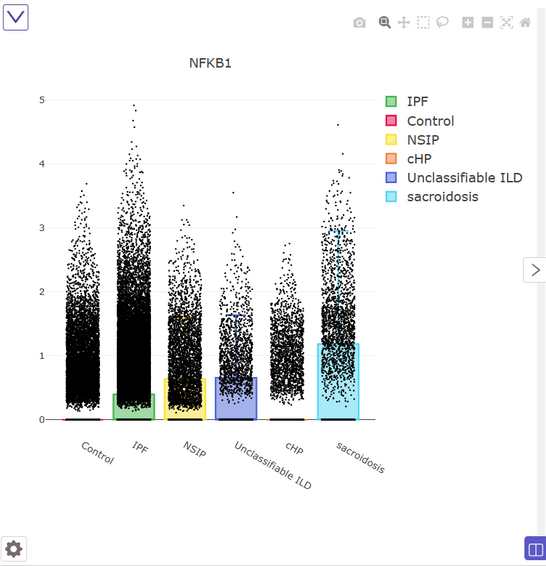
See the 'big picture' from multiple biological layers
“Integrated multi-omics is more than the sum of its parts.”
CDIAM Multi-Omics Studio is a web platform that supports scientists to utilize the full values of integrated omics data analysis with speed of development, adaptability and customization. CDIAM owns a microservice-based architecture and a command-line interface that enable bioinformaticians' speedy customizations, along with a graphical user interface accessible to all biologists.
Unite all the omics data in one single platform
The platform takes in data and analysis results from various types of omics such as Genomics, Transcriptomics, Proteomics, Epigenetics, Metabolomics, Microbiome, Interactome, Single Cell, and Spatial data. Inputs can be as simple as a gene/protein table, a DE result, or an expression matrix.
Genomics & Epigenomics
-
Mutation data
-
ATAC-seq
Transcriptomics
Proteomics
Metabolomics
Summarize findings across omics
Multi-omics data in a ‘project’ can be collectively analyzed for aggregate insights, or individually explored. Examples of such aggregate insights include: top ligand-receptor pairs, top cell types interacting with each other, overlapping significant pathways, potential targets, etc. commonly found across experiments.
State-of-the-art machine learning analyses and workflows in an intuitive UI
To help scientists easily interpret their omics data, CDIAM incorporates an easy-to-use graphical UI that accommodates a rich package of state-of-the-art machine learning algorithms and analysis workflows, for single-omics analysis and multi-omics analysis. The first machine learning algorithm that is integrated in CDIAM is “Extreme Gradient Boosting” (XGBoost), a variant of the Gradient Boosting Machine (GBM), a machine learning classifier developed by Chen et al. that has been widely applied for classification problems and predict biomarkers in biology. And many other exciting machine learning models are in development.
Unified Multi-Omics Data Management and Analysis
Easily explore the various types of omics data as individual datasets and as integrated analysis workflows that can be customized for optimal performance.
Adjustable Target and Biomarker Workflows
Choose from common workflow templates or customize your own. Safety, PD Biomarker, Mechanism of action and experiment planning workflows are in development.
Next Generation Pathway and Interactome Knowledgebase
Multiple pathway and interactome knowledge sources and workflows, including Pythia's Intercellular Signaling Prediction.

Integration and Customization
Microservices based cloud architecture enables rapid deployment, integration and customization.
-
Integration with public, third party and private data sources, pipelines and applications.

Why choose CDIAM for omics data analysis?
Simple deployment and access
CDIAM is an SAAS framework - meaning no installation. You can access the platform anywhere via common web browsers: Chrome, Firefox, Edge, Safari, you name it. The platform can be deployed either behind your organizations' firewall or using private cloud configurations.
Microservices for customization
The microservice-based architecture of CDIAM enables bespoke development, integration with public or internally built pipelines and tools (like R shiny data visualization applications) or even the ability to bring CDIAM capabilities to existing in-house computational resources.
Graphical user interface for ease of use
CDIAM aims to make it easier for all scientists to interpret and leverage the values of omics data. Thus, it is built in an interactive and intuitive graphical UI that is accessible to all biologists, regardless of their programming skills.
Data management and analysis -All in one place
The platform manages the data as individual datasets or groups them in ‘projects’. Multi-omics data in a ‘project’ can be collectively analyzed for aggregate insights, or individually explored. Examples of such aggregate insights include: top ligand-receptor pairs, top cell types interacting with each other, overlapping significant pathways, potential targets, etc. commonly found across experiments.
Scalability and adaptability for an exciting era of omics data
An exciting omics era requires platforms that have the scalability and adaptability to tackle massive amounts of data being generated every day, and a number of bioinformatics tools developed at a super-fast pace.
With that in mind, CDIAM comes with a microservice-based architecture that allows easy integration of new bioinformatics methods. It also comes with the scalability to handle huge datasets, e.g. single-cell datasets with hundreds of thousands of cells.


See how CDIAM supports various therapeutic areas
using real data
Parkinson's Disease
In this study, we used CDIAM to perform meta-analysis on Parkinson's Disease multi-omics data, including transcriptomics, proteomics and metabolomics datasets that were downloaded from public databases. The study unveiled meaningful cell-cell interactions and ligand-receptor pairs, identify important pathways, drug targets, and biomarkers to prioritize.
1
Type 2 Diabetes
Type 2 diabetes (T2D), the most prevalent form of diabetes, poses substantial burdens on human health and on global healthcare worldwide. To date, full recovery of T2D has not been reported. In this work, we performed a multi-omics analysis across transcriptomics, proteomics, and metabolomics T2D data with the support of the CDIAM platform to identify potential T2D targets and important ligand-receptor interactions.
3
Colorectal Cancer
Colorectal cancer has been one of the leading causes of cancer-related deaths worldwide. We conducted a study combining different -omics datasets of colorectal cancer using our platform CDIAM Multi-Omics Studio. Our study was able to identify some predominant signalling pathways, potential colorectal cancer biomarkers and therapeutic targets across multiple -omics experiments.
2
Inflammatory Bowel Disease
Although our understanding on the pathophysiology of IBD have greatly increased over the past several decades, which promotes its current management, there is still a considerable fraction of patients unresponsive to available treatments or failing to achieve clinical remission. In this study, we performed a meta-analysis of publicly available IBD datasets on C-DIAM, a multi-omics analytical software platform that offers custom tools to identify new therapeutic targets for IBD .
4
Discover important insights with CDIAM
Request a trial now to start analyzing your multi-omics data with CDIAM Multi-Omics Studio.



.png)









